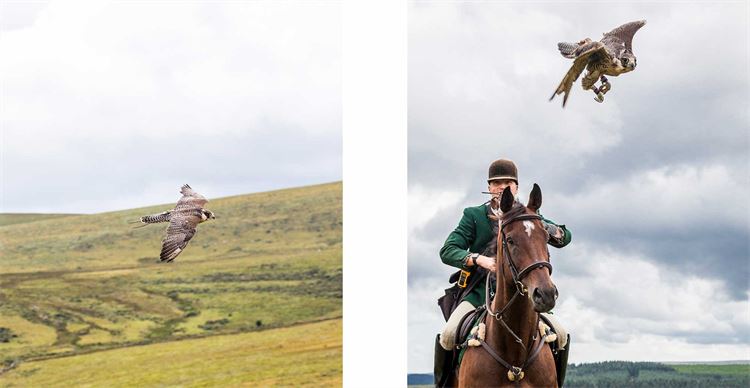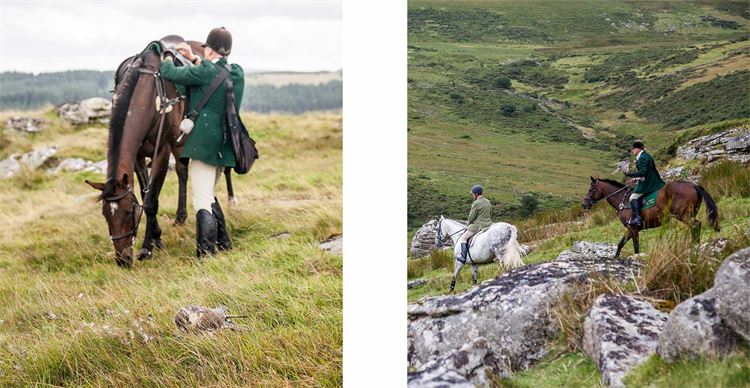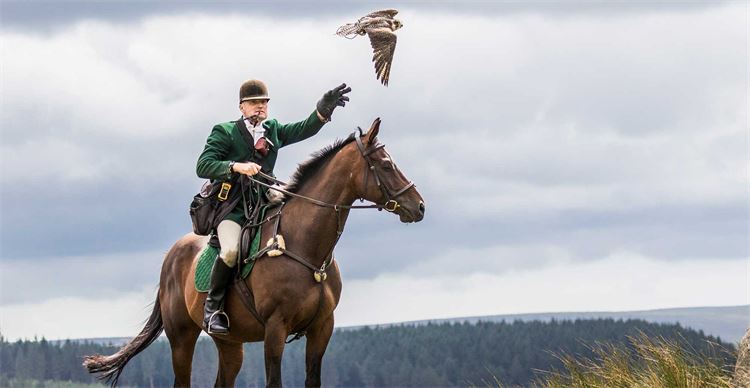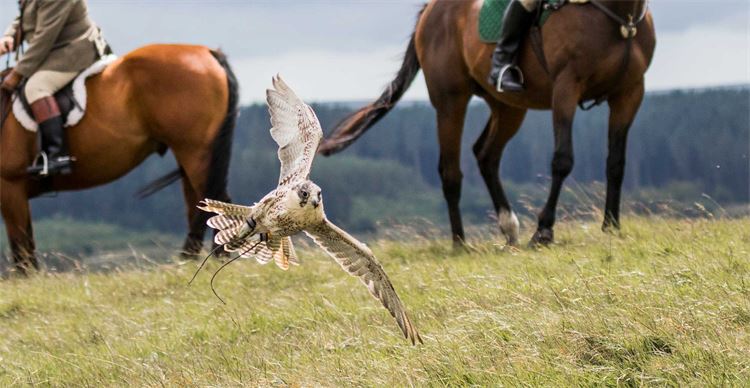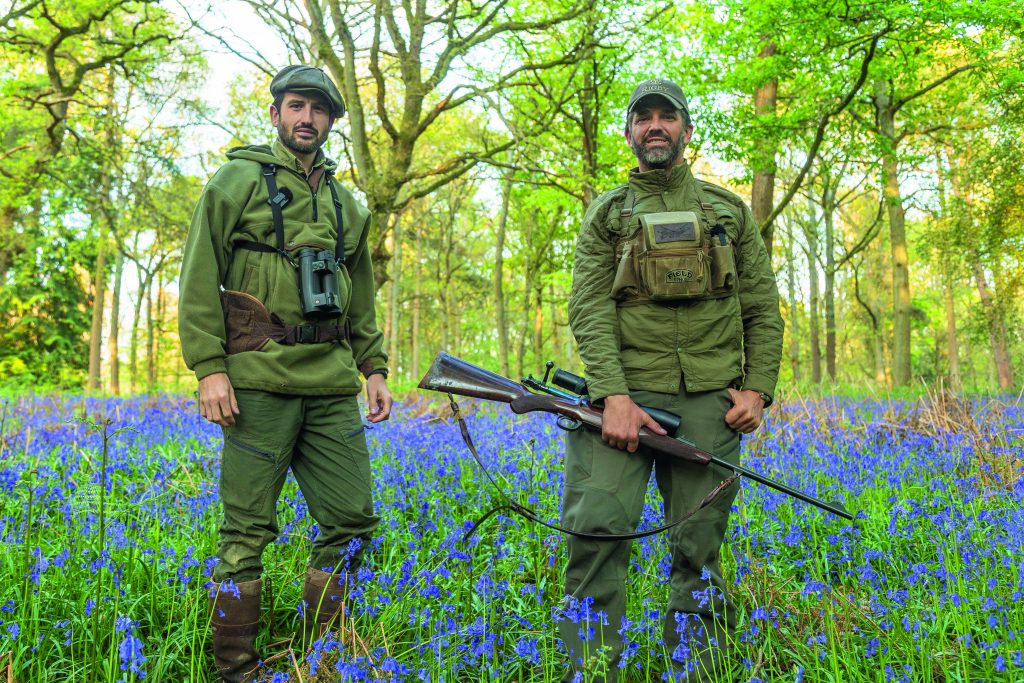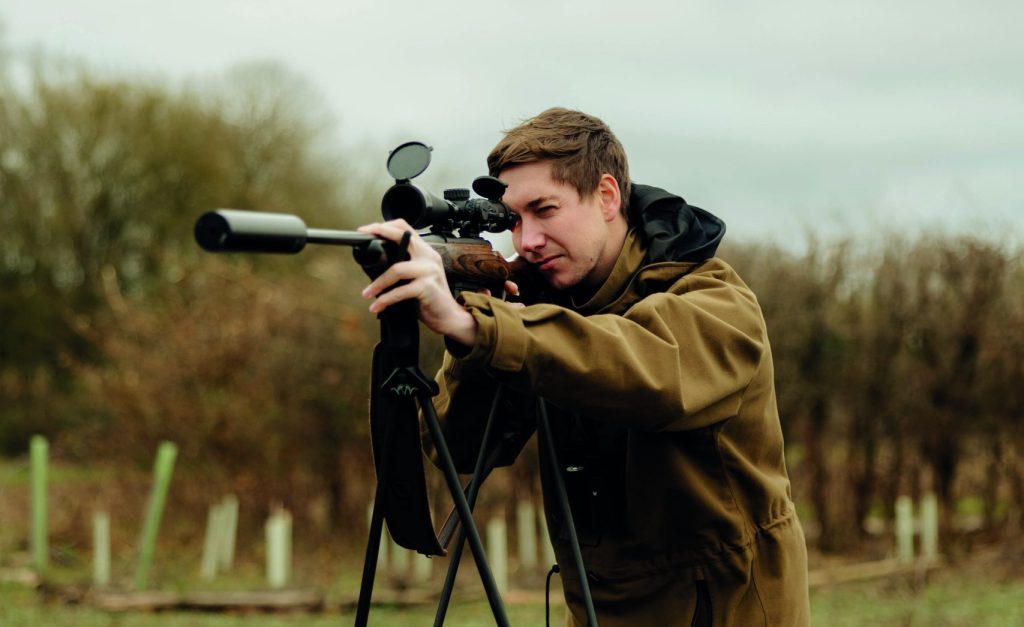Falconry on horseback
A day out with the Dartmoor Falcons proves that a crow doesn’t necessarily travel in that proverbial straight line.
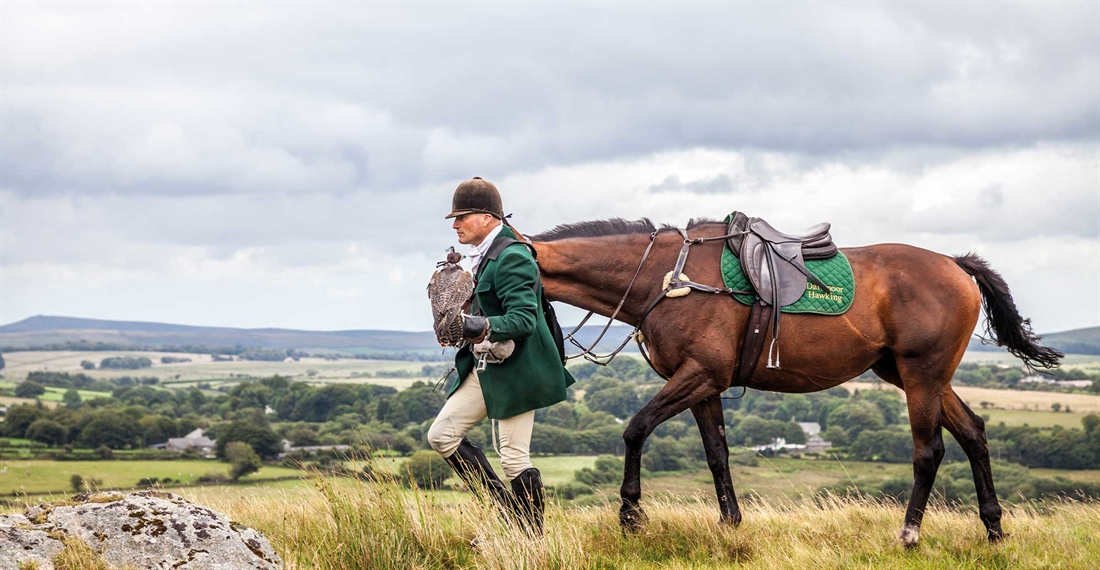
Whilst some of a sporting persuasion head off to the moors of Scotland and northern England in early August, I dared to be different and travelled to the somewhat less heather-clad moorland of Dartmoor in order to attend the opening meet of the Dartmoor Falcons who, between August and November (weather-permitting), fly at crows. It’s certainly a very different method of pest control but, on horse and with birds of prey, it is part of an ancient hunting tradition and one I was delighted to become acquainted with first-hand.
The crow-hawking is the ‘fun’ side of Martin Whitley’s extremely successful Dartmoor Hawking enterprise. As well as producing a near-daily demonstration at nearby Bovey Castle Hotel, Martin and his birds give displays at various shows and game fairs, and undertake private tuition for those who would either like to take up falconry in a serious way, or simply fancy having a go. You might see one or more of his 14 birds – ranging from a barn owl to a bald eagle – at any of these events; and his demonstrations are further enhanced by the fact that when Martin flies his birds, he does so from horseback. From ex-racehorses, in fact.
‘Recycled racehorses’ are how Martin refers to them. Some retire or don’t make the grade and, as Martin says: “It’s good to give a horse another lease of life. So we take them on, and I love working with them.”
Spectacular flying
For me, on that day in early August, I was happy to be mounted on the wonderful Leon, a hireling I’ve previously had the pleasure of riding whilst out following some of the Dartmoor-based hound packs during the winter. Owned by well-known hunting enthusiast Alex Warne, who runs both Equitour Sporting Holidays and Dartfordleigh Bed and Breakfast – I’ve been staying at the latter and enjoying the opportunities afforded by the former for several years. It was, though, my first time out with Martin and his falcons.
Limited to around a dozen riders – “too many people spoil the falconry” – my day turned out to be a very exclusive event as, due to various problems with the horses of some of the more regular followers, Alex, myself and Martin were the only ones riding. A small group of foot-followers did, however, make their way up to the top of Hartland Tor where we were treated to some spectacular flying from ‘Dawn’ and ‘Dusk’; two third-season hybrid cross peregrine/gyr-saker falcons. And, my goodness, how they flew – giving the photographers in our midst some perfect opportunities for some stupendous shots.
Although occupied with flying his birds (one at a time; it’s pure folly to fly two together as one would attempt to kill the other), there was the chance to talk to Martin about his very obvious love of falconry and how he came to get involved.
It all started with a trip to the Hawk Conservancy near Andover many moons ago. As a result, Martin began with Harris hawks and became fascinated by the work of Dr. Nick Fox, falconer, raptor biologist, conservationist, farmer and author who, in 2015, was awarded an OBE for his services to falconry and the conservation of raptors.
Dartmoor Hawking began in 2001, and the use of horses followed when Martin realised that not only do they make an arena display more spectacular, but they added immensely to a potential client’s hawking experience and, when it comes to falconry out on the moor, they allow access to places otherwise inaccessible to a vehicle, too. Slogging over such ground on foot would be impractical – as Martin points out: “We’ve had two-mile flights with our birds and it happens a lot faster than following hounds when they are in full cry, so you need a speedy horse.”
Fantastically agile
The first meet of the 2017 season was held at Dartfordleigh on August 4, at 1pm. Meets generally take place every Friday at the same time at various venues across Dartmoor. As one would when hunting with hounds, permission from landowners and commoners has to be gained and is generally the responsibility of the Master. Fortunately, having lived in the area all his life and having been involved with hunting in many forms (he was one-time Master of the Britannia Beagles and currently rides with all four of the hound packs based in the region), Martin is well-known and permission is readily given.
With the limited mounted field, I was able to ride up close to Martin and his falcon of choice for the start of the day, Dawn. Other birds that might be flown during the day are kept in his Land Rover and swapped over – after a kill, for example – to keep them keen and prevent exhaustion. It’s a ‘one-bird-one-kill-a-day’ policy.
So, how does one fly a falcon at crows? On occasion, there might be a couple of people in the area to be hunted who are scanning the skyline for potential quarry but, on the day I visited, it was a low-key day planned more for fun. Although crows were in short supply, the basic principle is, using the height of the horse as a ‘mobile missile launcher’, for a crow to be spotted, the falcon’s hood removed in double-quick time, the bird to spot its ‘enemy’ and be gone in rapid pursuit.
Surprisingly, given the nature of their natural instincts, not all birds of prey take to sporting opportunities such as this. Some decide that hunting crows is not for them, and some that do initially take to it might become ‘stale’ and much prefer life out on the demonstration circuit. There is, though, usually a reason; in fact, according to Martin, “there is always a reason, and I quite often wake at night trying to work it out. Never let hawks think that they can do better on their own without you.”
Asked what his favourite bird to fly is, Martin pointed to his gloved fist and said:“the bird that’s on there at the time!” Pressed as to what constitutes a ‘red letter day’ when out after crows, he had no hesitation in saying: “the day you get that ringing flight”, and explained what he meant. “If the crow is above the falcon, it knows it’s safe and so the falcon needs to get above the crow and ‘ring’ round it. Crows are fantastically agile and amazingly bright. They are certainly no pushover and a half-hearted falcon may find itself mobbed by crows. When all goes well, though, it’s the most fascinating and exciting sport.”
Out in the wilds, there’s surely a danger of losing a hawk or falcon in such conditions? It’s the opinion of many that correct training should mean that one need not worry about such things but even so, some form of contact between bird and handler is prudent. Tradition is served by the use of tail bells: those attached to the jesses such as are sometimes seen at game fair displays would get in the way of birds out on the hunting field, plus, on a kill, they wouldn’t be heard, whereas those attached to the tail can more readily be so. Modern technology is, though, more efficient and, in addition to bells, each bird has a tracker fitted when flying.
Tumbler’s Club
Despite our quarry species being less abundant than we might have hoped, the day was, nevertheless, as Martin mentioned, “fascinating and exciting” – and not without personal mishap. Despite having ridden Leon at a fast and furious pace on several other occasions, a short canter across the top of Hartland Tor saw he and I part company (my fault entirely) and, in doing so, I became the first to join this season’s Tumbler’s Club. An honour which necessitates a small fine to be paid. In all the excitement, I forgot to settle my dues at the end of the day and so I will have to make a point of rectifying this at some point in the near future – and that, of course, will mean another day on Dartmoor with Martin and his birds. I can’t wait!
Related Articles
Get the latest news delivered direct to your door
Subscribe to Fieldsports Journal
Elevate your experience in the field with a subscription to Fieldsports Journal, the premium publication for passionate country sports enthusiasts. This bi-monthly journal delivers unparalleled coverage of game shooting, fishing and big game across the UK and beyond.
Each issue offers a stunning collection of in-depth features, expert opinions and world-class photography, all presented in a timeless yet contemporary design.
Save 10% on shop price when you subscribe, with a choice of packages that work for you. Choose from Print & Digital or Digital only with each journal delivered directly to your door or via the app every other month, plus access to past issues with the digital back issue library.







